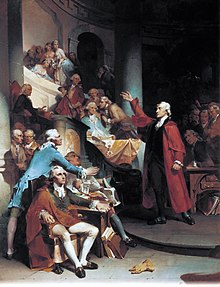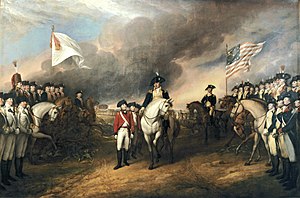Virginia in the American Revolution

The history of Virginia in the American Revolution begins with the role the Colony of Virginia played in early dissent against the British government and culminates with the defeat of General Cornwallis by the allied forces at the Siege of Yorktown in 1781, an event that signaled the effective military end to the conflict. Numerous Virginians played key roles in the Revolution, including George Washington, Patrick Henry, and Thomas Jefferson.
Antecedents
| History of Virginia |
|---|
|
|

Revolutionary sentiments first began appearing in Virginia shortly after the French and Indian War ended in 1763. The same year, the British and Virginian governments clashed in the Parson's Cause. The Virginia legislature had passed the Two-Penny Act to stop clerical salaries from inflating. King George III vetoed the measure, and clergy sued for back salaries. Patrick Henry first came to prominence by arguing in the case against the veto, which he declared tyrannical.
The
Opposition continued after the resolves. The Northampton County court overturned the Stamp Act February 8, 1766. Various political groups including the Sons of Liberty met and issued protests against the act. Most notably, Richard Bland published a pamphlet entitled An Enquiry into the Rights of the British Colonies. This document would set one of the basic political principles of the Revolution by stating that Virginia was a part of the British Empire, not the Kingdom of Great Britain, so it only owed allegiance to the Crown, not Parliament.
The Stamp Act was repealed, but additional taxation from the
In 1773, because of a renewed attempt to extradite Americans to Britain,
Following the closure of the port in Boston and several other offenses, the Burgesses approved June 1, 1774 as a day of "Fasting, Humiliation, and Prayer" in a show of solidarity with Massachusetts. The Governor,
War begins

On April 20, 1775, a day after the
On December 9, 1775, Virginia militia moved on the governor's forces at the Battle of Great Bridge. The British had held Fort Murray,[1] which guarded the land route to Norfolk. The British feared the militia, who had no cannon for a siege, would receive reinforcements, so they abandoned the fort and attacked. The militia won the 30-minute battle. Dunmore responded by bombarding Norfolk with his ships on January 1, 1776.
After the Battle of Great Bridge, little military conflict took place on Virginia soil for the first part of the
Independence

The
The constitution of the Fifth Virginia Convention created a system of government for the state that would last for 54 years. The constitution provided for a chief magistrate, a bicameral legislature with both the House of Delegates and the Senate. The legislature elected a governor each year (picking Patrick Henry to be the first) and a council of eight for executive functions. In October, the legislature appointed Jefferson, Edmund Pendleton, and George Wythe to adopt the existing body of Virginia law to the new constitution.
War returns to Virginia
The British brought the war back to coastal Virginia in May 1779 when Admiral
Raid of Richmond
Fearing the vulnerability of Williamsburg, then-
In December, Benedict Arnold, who had betrayed the Patriot/Continental movement and was afterwards positioned as a General in the British Army, attacked Richmond with a militia of Loyalists as well as Hessian mercenaries and an army of British Regulars. Jefferson fled the capital city and called out militia under Colonel Sampson Mathews to harass Arnold's forces.[2][3] They burned much of the city before withdrawing to Portsmouth, burning and looting along the James River as they went.[4]
Yorktown Campaign
Arnold moved his base of operations to Portsmouth and was later joined by another 2,000 troops under General
George Washington sent the French
Under orders from General Clinton, Cornwallis moved down the

Cornwallis moved his troops across the James to Portsmouth to await Clinton's orders. Clinton decided that a position on the peninsula must be held and that Yorktown would be a valuable naval base. Cornwallis received orders to move his troops to Yorktown and begin construction of fortifications and a naval yard. The Americans had initially expected Cornwallis to move either to New York or the Carolinas and started to make arrangements to move from Virginia. Once they discovered the fortifications at Yorktown, the Americans began to place themselves around the city.
Gen. Washington saw the opportunity for a major victory. He moved a portion of his troops, along with
Between October 6 and 17 the American forces laid siege to Yorktown. Outgunned and completely surrounded, Cornwallis decided to surrender. Papers for surrender were officially signed on October 19. As a result of the defeat, the king lost control of Parliament and the new British government offered peace in April 1782. The Treaty of Paris of 1783 officially ended the war.
See also
References
- ^ "Hampton Roads Area - Fort Murray". American Forts Network. Retrieved 13 August 2020.
- ^ "From Thomas Jefferson to Sampson Mathews, 12 January 1781 Founders Online, National Archives," last modified July 11, 2019, https://founders.archives.gov/documents/Jefferson/01-04-02-0417. [Original source: The Papers of Thomas Jefferson, vol. 4, 1 October 1780 – 24 February 1781, ed. Julian P. Boyd. Princeton: Princeton University Press, 1951, p. 343]
- ^ Bryan, Charles (October 25, 2014). "Richmond's Benedict Arnold". Richmond Times Dispatch. Richmond, Virginia. Retrieved July 11, 2019.
- ^ Theobald, Mary. ""Whatever Happened to Benedict Arnold?"". History.org. Colonial Williamsburg. Retrieved 3 August 2015.

